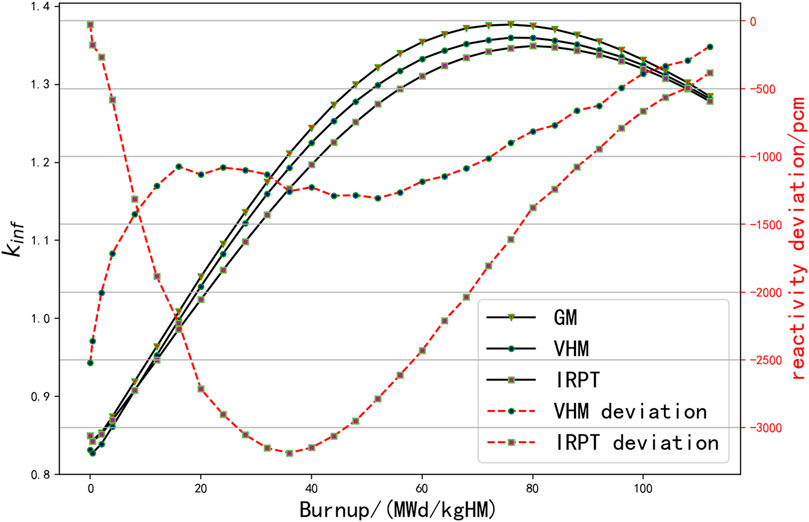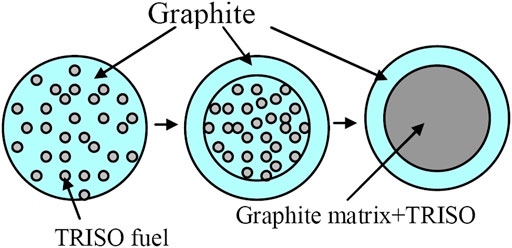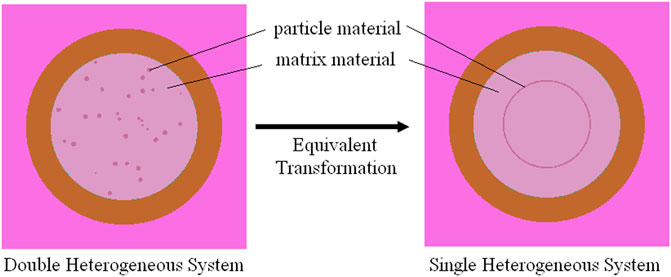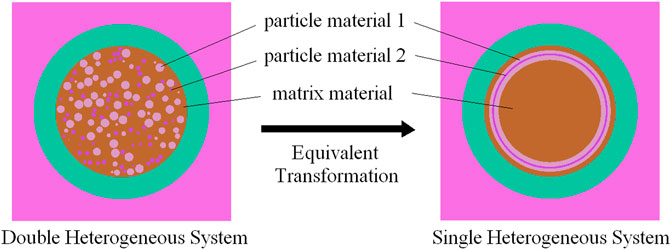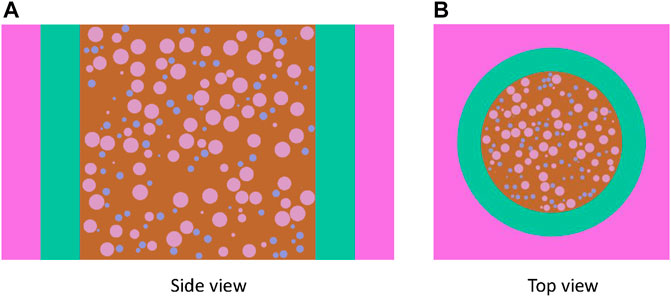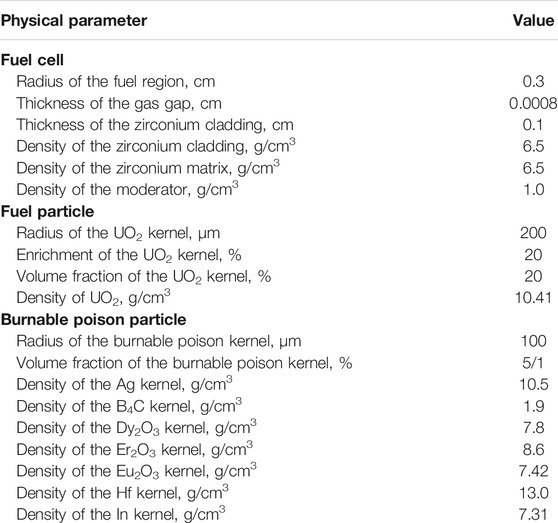The Ring RPT Method for DH Systems Containing Dispersed Particle-Type of Fuel and Burnable Poisons
- Science and Technology on Reactor System Design Technology Laboratory, Nuclear Power Institute of China, Chengdu, China
Because dispersed particle-type fuel and burnable poisons both have double heterogeneity (DH), using the traditional volumetric homogenization method (VHM) to treat DH systems will bring about large reactivity calculation deviation. The improved reactivity-equivalent physical transformation (IRPT) method can be applied to DH systems which have both dispersed particle-type fuel and burnable poisons because of the features of simplicity and high calculation accuracy. In this article, the calculations show that the IRPT method becomes invalid for some DH systems when the volume fraction of dispersed particle-type burnable poisons is relatively high or the absorb cross section of burnable poison particles is relatively large. Then the two-step ring reactivity-equivalent physical transformation (TRRPT) method is proposed to be applied to the DH systems with both dispersed particle-type fuel and burnable poisons. Results of reactivity at zero burnup and depletion calculations for different types of dispersed particle-type fuel and burnable poisons and the comparison with Monte Carlo results of grain models prove the validity of the TRRPT method, and it has been proven that the TRRPT method has higher accuracy in reactivity calculation and a wider scope of transformation than the IRPT method.
1 Introduction
Dispersed particle-type fuels (IAEA-TECDOC-1797, 2014) and burnable poisons (van Dam, 2000) have attracted much attention due to their unique physical properties. Dispersed particle-type fuel can contain fission products under high temperature and deep burnup conditions and has accident-resistant characteristics. Dispersed particle-type burnable poisons can increase the surface compatibility of particles and the matrix by adding a coating layer, and at the same time, it can control the burnup rate through its own space self-shielding effect and improve the flexibility of using burnable poisons in reactivity control. Dispersed particle-type fuel and burnable poisons have double heterogeneity (DH), that is, on the basis of the heterogeneity of the fuel pin, cladding, and moderator, the heterogeneity of the dispersed particles in the fuel pin and the matrix is added. The DH cannot be described in the current traditional neutronics calculation program, and the direct use of the volume homogenization method will bring about a larger reactivity calculation deviation.
A large number of studies have been conducted on the DH of dispersed materials at home and abroad. At present, there are two major types of methods for DH. The first is the Monte Carlo method, which can be used to directly simulate the dispersed particles using the Monte Carlo program, but the calculation will take a long time and require lots of memory. The second category is the deterministic method, which involves adding a certain algorithm to the present deterministic program to realize the treatment of DH. There are also many deterministic treatment methods for DH (Zhang et al., 2017a). One is the equivalent homogenization method of Shmakov (Shmakov et al., 2000) and She Ding (Ding et al., 2017), which can handle the DH effects of the cross section of the nonresonant energy group, and the resonance energy groups need to be dealt with separately using other methods such as the Dancoff factor correction or the Monte Carlo method. Sanchez’s DH treatment method based on the method of characteristic (MOC) and the collision probability method (CPM) (Sanchez and Masiello, 2002; Zhang et al., 2017b) can also be applied to DH. The equivalent homogenization method and Sanchez’s method both require more formula derivation and a lot of modifications to existing programs. Another method is the reactivity-equivalent physical transformation (RPT) method proposed by Yonghee Kim (Kim et al., 2006) in South Korea, which converts the DH system into a single-heterogeneous (SH) system by performing a reactive equivalent transformation of the system based on the reactivity of the Monte Carlo particle model at the time of zero burnup. Then the traditional neutronics program is used to calculate. The method is simple to operate, but the calculation accuracy is acceptable.
In 2018, Jian Li (Li et al., 2018) from Tsinghua University proposed an improved reactivity-equivalent physical transformation (IRPT) method, which is an improved RPT method for fully ceramic microencapsulated (FCM) fuel dispersed both particle-type fuel and burnable poisons. When processed using the IRPT method, the FCM fuel region is divided into three ring zones which will be homogenized separately. Numerical results of FCM fuel show that the IRPT method can be used to treat these cases containing both dispersed particle-type fuel and burnable poisons.
In 2020, we conducted in-depth research based on the RPT method and proposed a ring RPT (RRPT) method, which can be used to process the single particle-type DH system of dispersed particle-type fuel or burnable poisons (Lou et al., 2020a; Lou et al., 2020b). The reactivity calculation accuracy is higher than that of the traditional RPT method. In order to be able to deal with the two types of particle DH systems containing both dispersed particle-type fuel and burnable poisons, this article will conduct a more in-depth study.
In this article, it is found that for the cases with dispersed particle-type burnable poisons, when its macro cross section is relatively large or its volumetric fraction is relatively high or its particle size is relatively large or its burnup is relatively deep, the IRPT method will also have large deviations. Figure 1 shows the reactivity curve of FCM fuel with dispersed particle-type B4C. In this case, the diameter of the B4C particle is 100 μm, and its volumetric fraction is 5%.
For the issue above, in this article, the RRPT method for systems with dispersed particles is proposed. With the RRPT method, all the dispersed particles are compressed to be a ring column for a cylindrical cell or a ring shell for a spherical cell, and the double-heterogeneous system is also transformed into an SH system as the traditional RPT method does. When the DH system contains both particle dispersed fuel and burnable poisons, the RRPT method can be used twice to transform the fuel particles and burnable poison particles into corresponding rings which are an SH system and can be modeled using the traditional neutronic program. The calculation results and comparison with Monte Carlo results show that the RRPT method can deal with systems containing both fuel particles and burnable poison particles and has higher calculation accuracy in reactivity calculation and a wider scope of application than the original IRPT method.
2 Methodology
2.1 RPT and IRPT Methods
In the traditional RPT method, the DH problem with dispersed particles will be transformed into an SH system which can be modeled using a traditional program. The transformation process contains two steps: first, gather all the particles into a smaller circular area with a higher packing fraction than before in the center region, and second, the new smaller circular area is treated using the VHM (see Figure 2 (Kim et al., 2006)) The RPT radius which is the radius of the smaller circular area is determined by keeping the kinf of the system equivalent to the reference value which is usually calculated using the Monte Carlo or high-fidelity deterministic programs.
For the DH system with both dispersed particle-type fuel and burnable poison, the schematic diagram of the IRPT method is shown in Figure 3 (Li et al., 2018). First, we assume that the DH system does not contain burnable poison particles, only fuel particles, and then the RPT radius can be obtained using the traditional RPT method. Then burnable poison is reverted to the fuel region within the RPT radius, and the traditional RPT method is used twice to get a smaller RPT radius. After being processed twice using the traditional RPT method, the FCM fuel region is divided into three circular areas. The outer region contains only matrix material, the middle zone contains the matrix and particle-type fuel, and the inner zone contains the matrix, particle-type fuel, and particle-type burnable poisons. The dispersed particles in the inner zone and the middle zone are homogenized separately.
2.2 RRPT and TRRPT Methods
The RRPT method can also transform the DH problem into an SH one which can be modeled using the traditional neutronic program. The whole process of the RRPT method contains only one step, which is shown in Figure 4. First, all dispersed particle material is compressed into a ring area in the matrix material, and the center of the ring is consistent with the fuel cell. There is a corresponding relationship between the inner and outer radii of the ring when keeping the entire dispersed particle material constant during the transformation. The radius of the ring is determined by keeping the kinf of the system equivalent to the reference results of the Monte Carlo or high-fidelity deterministic program.
When the DH systems contain two types of dispersed particles, such as fuel particles and burnable poison particles, the RRPT method can also be used with the IRPT idea. First, we assume that the DH system does not contain burnable poison particles, only fuel particles, and then the radius of the fuel ring can be determined using the RRPT method. Then burnable poison is reverted to the fuel region, and a new radius of the burnable poison ring can be determined using the RRPT method. After being processed twice using the RRPT method, the FCM fuel region is divided into three circular areas, namely, the matrix zone, the fuel zone, and the burnable poison zone. The matrix zone contains only matrix material, the fuel zone contains only fuel material, and the burnable poison zone contains only burnable poison, which is shown in Figure 5.
In the TRRPT and IRPT methods, the first step of treatment needs to remove the dispersed burnable poison particles in the system, and the second step of treatment needs to add the dispersed burnable poison particles to the fuel region in the system. The reason for removing and regaining burnable poison particles is that the traditional RPT method and the RRPT method are both applied to single-type particles. When the DH system contains both particle-dispersed fuel and burnable poison, the two types of particles need to be treated separately. The new methods of treating with the traditional RPT and RRPT methods twice are the IRPT and TRRPT methods.
Generally, the content of burnable poison particles is much less than that of fuel particles, and so the area of the burnable poison ring is much smaller than that of the fuel ring. In all the examples verified in this study, the burnable poison ring is contained inside the fuel ring, as shown in Figure 5.
3 Numerical Results
In this article, the Monte Carlo program RMC (Wang et al., 2013), which was developed by Tsinghua University, is used to describe the random distribution of dispersed particles in the matrix and to provide a benchmark solution. When fuel particles with a radius of 200 μm and a volume fraction of 20% and burnable poison particles with a radius of 100 μm and a volume fraction of 5% are dispersed randomly in the zirconium matrix, the schematic diagram of distribution is shown in Figure 6. The parameters of the calculation model are shown in Table 1. In the two-type dispersed particle system, the dispersed particles are burnable poison and UO2. The parameters of the calculation model are shown in Table 1.
The models with dispersed particle-type fuel and burnable poisons are, respectively, calculated using the grain model (GM), the VHM, the IRPT method, and the TRRPT method, and the results of reactivity and calculation deviation are shown in Figure 7.
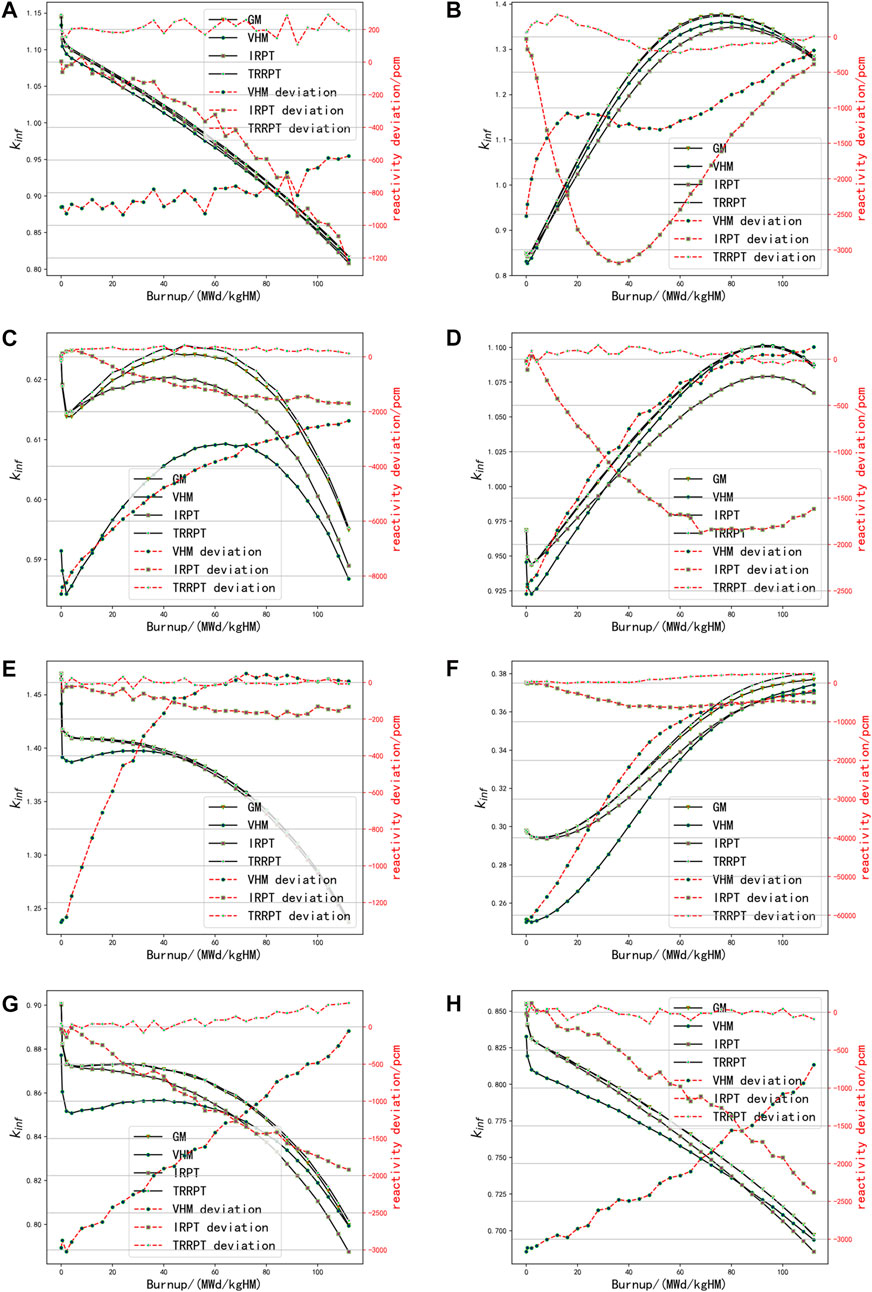
FIGURE 7. Reactivity and calculation deviation of different methods. (A) Ag-V5%. (B) B4C-V5%. (C) Dy2O3-V5%. (D) Er2O3-V5%. (E) Er2O3-V1%. (F) Eu2O3-V5%. (G) Hf-V5%. (H) In-V5%.
In Figure 7, the GM is the results of the grain model of the DH systems and is the benchmark. In the calculation, the burnable poison particles are divided into 10 burnup zones for accurate results.
When the volume fraction of burnable poison is relatively low, such as Er2O3 with a volume fraction of 1% as shown in (e) of Figure 7, the IRPT and TRRPT methods can both treat such problems with low reactivity deviation. But when the volume fraction becomes large, such as 5%, the reactivity calculating deviation of the IRPT method becomes large, the deviation will gradually increase with the depletion, and the maximum deviation will exceed 500 pcm.
When the TRRPT method is used, not only can the cases the IRPT method is suitable for get perfect results but also the reactivity calculation deviation of the cases with a relatively large volume fraction and burnable poison with a large absorb cross section such as B4C stays within 500 pcm during the depletion. The TRRPT method which transforms the dispersed particle-type burnable poisons into a ring can better simulate the space self-shielding effect of the particles in the DH systems than the IRPT method.
4 Conclusion
In this study, the IRPT method, improved from the traditional RPT method, is introduced to deal with the DH system with dispersed particle-type fuel and burnable poisons; results compared with Monte Carlo show that the reactivity calculation deviation of the IRPT method will be relatively large for the DH systems with burnable poison particles which have a relatively large volume fraction or a large absorption cross section. Then the RRPT method can be used twice to treat the DH system with two types of dispersed particles. The TRRPT method is proposed, which can not only treat the cases the IRPT method is suitable for but also the cases that the IRPT method cannot treat; the maximum reactivity calculation deviation stays within 500 pcm during the depletion. The calculation results and comparison with Monte Carlo show that the TRRPT method has higher accuracy in reactivity calculation and a wider scope of transformation than the IRPT method.
Data Availability Statement
The raw data supporting the conclusion of this article will be made available by the authors, without undue reservation.
Author Contributions
LL: conceptualization, methodology, and software. XP: conceptualization. XC: conceptualization. DY: conceptualization. ML: visualization and investigation. LW: funding acquisition and supervision. LC: funding acquisition and supervision.
Funding
This work is supported by the National Natural Science Foundation of China (Approved no.: 1170051016).
Conflict of Interest
All authors were employed by company Nuclear Power Institute of China.
Publisher’s Note
All claims expressed in this article are solely those of the authors and do not necessarily represent those of their affiliated organizations, or those of the publisher, the editors and the reviewers. Any product that may be evaluated in this article, or claim that may be made by its manufacturer, is not guaranteed or endorsed by the publisher.
References
Ding, S., Liu, Z., and Shi, L. (2017). An Equivalent Homogenization Method for Treating the Stochastic Media, Nucl. Sci. Eng., volume 185, 351–360.
IAEA-TECDOC-1797 (2014). “Accident Tolerant Fuel Concepts for Light Water Reactor.” in Proceedings of a Technical Meeting held at Oak Ridge National Labratories, United States of America, 13-16.
Kim, Y., Kim, K-S., and Noh, J. M. (2006). Preservation of Fuel Characteristics in the RPT Method, Transactions of the Korean Nuclear Society Spring Meeting, Chuncheon, Korea.
Li, J., She, D., and Shi, L. (2018). An Improved Reactivity-Equivalent Physical Transformation for Treating FCM Fuel with Burnable Poisons. Ann. Nucl. Energ. 121, 577–581. doi:10.1016/j.anucene.2018.08.024
Lou, L., Chai, X., Yao, D., Peng, X., Chen, L., Li, M., et al. (2020). Research of Ring RPT Method on Spherical and Cylindrical Double-Heterogeneous Systems. Ann. Nucl. Energ. 147, 107741. doi:10.1016/j.anucene.2020.107741
Lou, L., Yao, D., Chai, X., Peng, X., Li, M., Li, W., et al. (2020). A Novel Reactivity-Equivalent Physical Transformation Method for Homogenization of Double-Heterogeneous Systems. Ann. Nucl. Energ. 142, 107396. doi:10.1016/j.anucene.2020.107396
Sanchez, R., and Masiello, E. (2002). Treatment of the Double Heterogeneity with the Method of Characteristics. Seoul, Korea: PHYSOR. (. (7-10 October, 2002).
Shmakov, V. M., Lyutov, V. D., and Dean, V. F. (2000). Effective Cross Sections for Calculations of Criticality of Dispersed Media, Proc Advances in Reactor Physics, and Mathematics and Computation into the Next Millennium (PHYSOR 2000, Pittsburgh, Pennsylvania).
van Dam, H. (2000). Long-term Control of Excess Reactivity by Burnable Particles. Ann. Nucl. Energ. 27, 733–743. doi:10.1016/s0306-4549(00)82014-9
Wang, K., Li, Z. G., and She, D. (2013). RMC-A Monte Carlo Code for Reactor Physics analysisJoint International Conference on Supercomputing in Nuclear Applications and Monte Carlo. Paris: France.
Zhang, T., Lewis, E. E., Smith, M. A., Yang, W. S., and Wu, H. (2017). A Variational Nodal Approach to 2D/1D Pin Resolved Neutron Transport for Pressurized Water Reactors. Nucl. Sci. Eng. 186 (2), 120–133. doi:10.1080/00295639.2016.1273023
Keywords: particle-type fuel, particle-type burnable poisons, double-heterogeneous systems, volumetric homogenization method, IRPT method, ring RPT method
Citation: Lou L, Peng X, Chai X, Yao D, Li M, Wang L and Chen L (2021) The Ring RPT Method for DH Systems Containing Dispersed Particle-Type of Fuel and Burnable Poisons. Front. Energy Res. 9:704307. doi: 10.3389/fenrg.2021.704307
Received: 02 May 2021; Accepted: 30 June 2021;
Published: 11 August 2021.
Edited by:
Tengfei Zhang, Shanghai Jiao Tong University, ChinaCopyright © 2021 Lou, Peng, Chai, Yao, Li, Wang and Chen. This is an open-access article distributed under the terms of the Creative Commons Attribution License (CC BY). The use, distribution or reproduction in other forums is permitted, provided the original author(s) and the copyright owner(s) are credited and that the original publication in this journal is cited, in accordance with accepted academic practice. No use, distribution or reproduction is permitted which does not comply with these terms.
*Correspondence: Xiaoming Chai, chaixm@163.com
 Lei Lou
Lei Lou Xingjie Peng
Xingjie Peng Xiaoming Chai*
Xiaoming Chai*  Lianjie Wang
Lianjie Wang